Yamaha UW500 User Manual
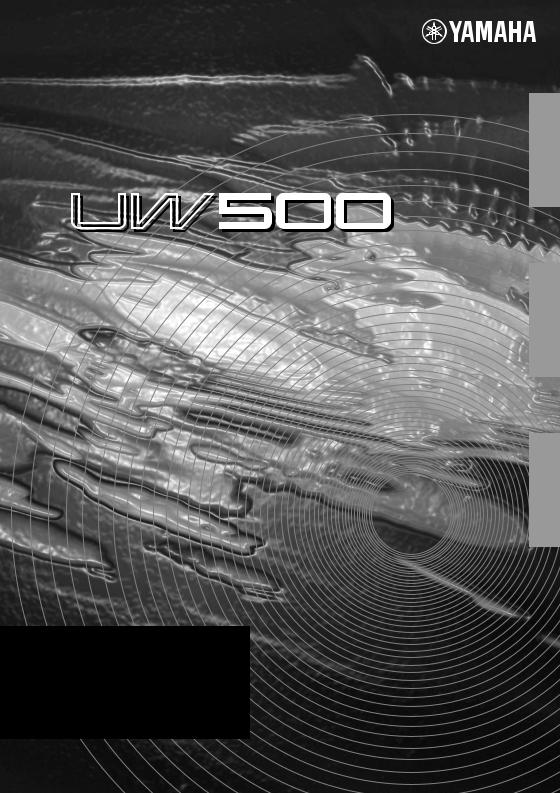
USB AUDIO/MIDII / I I PERSONALL STUDIOT IO
English
Deutsch
Français
Owner‘s Manual
Bedienungsanleitung
Mode d’emploi

SPECIAL MESSAGE SECTION
This product utilizes batteries or an external power supply (adapter). DO NOT connect this product to any power supply or adapter other than one described in the manual, on the name plate, or specifically recommended by Yamaha.
WARNING: Do not place this product in a position where anyone could walk on, trip over ,or roll anything over power or connecting cords of any kind. The use of an extension cord is not recommended! IF you must use an extension cord, the minimum wire size for a 25' cord (or less ) is 18 AWG. NOTE: The smaller the AWG number ,the larger the current handling capacity. For longer extension cords, consult a local electrician.
This product should be used only with the components supplied or; a cart, rack, or stand that is recommended by Yamaha. If a cart, etc., is used, please observe all safety markings and instructions that accompany the accessory product.
SPECIFICATIONS SUBJECT TO CHANGE:
The information contained in this manual is believed to be correct at the time of printing. However, Yamaha reserves the right to change or modify any of the specifications without notice or obligation to update existing units.
This product, either alone or in combination with an amplifier and headphones or speaker/s, may be capable of producing sound levels that could cause permanent hearing loss. DO NOT operate for long periods of time at a high volume level or at a level that is uncomfortable. If you experience any hearing loss or ringing in the ears, you should consult an audiologist.
IMPORTANT: The louder the sound, the shorter the time period before damage occurs.
Some Yamaha products may have benches and / or accessory mounting fixtures that are either supplied with the product or as optional accessories. Some of these items are designed to be dealer assembled or installed. Please make sure that benches are stable and any optional fixtures (where applicable) are well secured BEFORE using.
Benches supplied by Yamaha are designed for seating only. No other uses are recommended.
NOTICE:
Service charges incurred due to a lack of knowledge relating to how a function or effect works (when the unit is operating as designed) are not covered by the manufacturer’s warranty, and are therefore the owners responsibility. Please study this manual carefully and consult your dealer before requesting service.
ENVIRONMENTAL ISSUES:
Yamaha strives to produce products that are both user safe and environmentally friendly. We sincerely believe that our products and the production methods used to produce them, meet these goals. In keeping with both the letter and the spirit of the law, we want you to be aware of the following:
Battery Notice:
This product MAY contain a small non-rechargeable battery which (if applicable) is soldered in place. The average life span of this type of battery is approximately five years. When replacement becomes necessary, contact a qualified service representative to perform the replacement.
This product may also use “household” type batteries. Some of these may be rechargeable. Make sure that the battery being charged is a rechargeable type and that the charger is intended for the battery being charged.
When installing batteries, do not mix batteries with new, or with batteries of a different type. Batteries MUST be installed correctly. Mismatches or incorrect installation may result in overheating and battery case rupture.
Warning:
Do not attempt to disassemble, or incinerate any battery. Keep all batteries away from children. Dispose of used batteries promptly and as regulated by the laws in your area. Note: Check with any retailer of household type batteries in your area for battery disposal information.
Disposal Notice:
Should this product become damaged beyond repair, or for some reason its useful life is considered to be at an end, please observe all local, state, and federal regulations that relate to the disposal of products that contain lead, batteries, plastics, etc. If your dealer is unable to assist you, please contact Yamaha directly.
NAME PLATE LOCATION:
The name plate is located on the top panel of the product. The name plate lists the product’s model number, power requirements, and other information. The serial number is located on the rear panel. Please record the model number, serial number, and date of purchase in the spaces provided below, and keep this manual as a permanent record of your purchase.
Model
Serial No.
Purchase Date
92-BP (others) PLEASE KEEP THIS MANUAL

PRECAUTIONS
PLEASE READ CAREFULLY BEFORE PROCEEDING
* Please keep these precautions in a safe place for future reference.
WARNING
Always follow the basic precautions listed below to avoid the possibility of serious injury or even death from electrical shock, short-circuiting, damages, fire or other hazards. These precautions include, but are not limited to, the following:
•Do not open the instrument or attempt to disassemble the internal parts or modify them in any way. The instrument contains no user-serviceable parts. If it should appear to be malfunctioning, discontinue use immediately and have it inspected by qualified Yamaha service personnel.
•Do not expose the instrument to rain, use it near water or in damp or wet conditions, or place containers on it containing liquids which might spill into any openings.
•If the AC adaptor cord or plug becomes frayed or damaged, or if there is a sudden loss of sound during use of the instrument, or if any unusual smells or smoke should appear to be caused by it, immediately turn off
the power switch, disconnect the adaptor plug from the outlet, and have the instrument inspected by qualified Yamaha service personnel.
•Use the specified adaptor (PA-3B or an equivalent recommended by Yamaha) only. Using the wrong adaptor can result in damage to the instrument or overheating.
•Before cleaning the instrument, always remove the electric plug from the outlet. Never insert or remove an electric plug with wet hands.
•Check the electric plug periodically and remove any dirt or dust which may have accumulated on it.
 CAUTION
CAUTION
Always follow the basic precautions listed below to avoid the possibility of physical injury to you or others, or damage to the instrument or other property. These precautions include, but are not limited to, the following:
•Do not place the AC adaptor cord near heat sources such as heaters or radiators, and do not excessively bend or otherwise damage the cord, place heavy objects on it, or place it in a position where anyone could walk on, trip over, or roll anything over it.
•When removing the electric plug from the instrument or an outlet, always hold the plug itself and not the cord.
•Do not connect the instrument to an electrical outlet using a multiple-connector. Doing so can result in lower sound quality, or possibly cause overheating in the outlet.
•Unplug the AC power adaptor when not using the instrument, or during electrical storms.
•Before connecting the instrument to other electronic components, turn off the power for all components. Before turning the power on or off for all components, set all volume levels to minimum. Also, be sure to set the volumes of all components at their minimum levels and gradually raise the volume controls while playing the instrument to set the desired listening level.
•Do not expose the instrument to excessive dust or vibrations, or extreme cold or heat (such as in direct sunlight, near a heater, or in a car during the day) to prevent the possibility of panel disfiguration or damage to the internal components.
•Do not use the instrument near other electrical products such as televisions, radios, or speakers, since this might cause interference which can affect proper operation of the other products.
•Do not place the instrument in an unstable position where
(3)-6 it might accidentally fall over.
•Before moving the instrument, remove all connected adaptor and other cables.
•When cleaning the instrument, use a soft, dry cloth. Do not use paint thinners, solvents, cleaning fluids, or chemical-impregnated wiping cloths. Also, do not place vinyl, plastic or rubber objects on the instrument, since this might discolor the panel or keyboard.
•Do not rest your weight on, or place heavy objects on the instrument, and do not use excessive force on the buttons, switches or connectors.
•Do not operate the instrument for a long period of time at a high or uncomfortable volume level, since this can cause permanent hearing loss. If you experience any hearing loss or ringing in the ears, consult a physician.
Yamaha cannot be held responsible for damage caused by improper use or modifications to the instrument, or data that is lost or destroyed.
Always turn the power off when the instrument is not in use.

Welcome to the UW500
Thank you for choosing the Yamaha UW500 USB Audio/MIDI Personal Studio. The UW500 is a USB interface that enables simultaneous transfer of audio and MIDI data. Connect the UW500 to a computer that has a USB port and enjoy the powerful features of digital audio.
Please read this owner’s manual thoroughly to make the best use of the UW500. After you read this manual, please keep it in a safe place for future reference.
SPECIAL NOTICES
•The software and this owner’s manual are exclusive copyrights of Yamaha Corporation.
•Use of the software and this manual is governed by the license agreement which the purchaser fully agrees to upon breaking the seal of the software packaging. (Please read carefully the Software Licensing Agreement at the end of this manual before installing the application.)
•Copying of the software or reproduction of this manual in whole or in part by any means is expressly forbidden without the written consent of the manufacturer.
•Yamaha makes no representations or warranties with regard to the use of the software and documentation and cannot be held responsible for the results of the use of this manual and the software.
•This disk is a CD-ROM. Do not attempt to play the disk on an audio CD player. Doing so may result in irreparable damage to your audio CD player.
•Copying of the commercially available music sequence data and/or digital audio files is strictly prohibited except for your personal use.
•The company names and product names in this Owner’s Manual are the trademarks or registered trademarks of their respective companies.
•The screen displays as illustrated in this Owner’s Manual are for instructional purposes, and may appear somewhat different from the screens which appear on your computer.
•Future upgrades of application and system software and any changes in specifications and functions will be announced separately.
* “SoftSynthesizer” is a trademark of Yamaha Corporation.
4

Table of contents |
|
UW500 Features .................................................................................. |
6 |
Notes on USB ................................................................................................ |
7 |
Notes on musical copyrights.......................................................................... |
8 |
Package Contents ............................................................................... |
9 |
About the included software .......................................................................... |
9 |
System Requirements ....................................................................... |
11 |
Parts and Functions........................................................................... |
12 |
Connection........................................................................................ |
16 |
Installing the Driver .......................................................................... |
22 |
Playing the Demo Song .................................................................... |
32 |
Hard Disk Recording ......................................................................... |
34 |
Creating a Song Using Sample Phrases............................................ |
40 |
Changing the driver setting (MIDI Patch Screen) ........................... |
44 |
Specifications .................................................................................... |
50 |
Troubleshooting (FAQ)..................................................................... |
51 |
5

UW500 Features
• Transferring audio and MIDI data simultaneously
You can use audio data and MIDI data at the same time.
The audio inputs and outputs of the UW500 support both analog signals (microphone input and line input/output) and digital signals (optical input/output). MIDI data is transferred via the MIDI IN/OUT terminals and TO TG terminal (which is equivalent to a computer’s serial port). Multiple-port configuration (6 MIDI outputs and 2 MIDI inputs) reinforces a powerful musical production environment.
• Producing a clear sound
Usually, if you try to record audio using a computer’s audio input jack, computer noise is introduced and lowers the audio quality during the analog-to-digital conversion. The UW500, however, converts analog input signals into digital, which enables you to record clear sound to your hard disk.
• The included software supports a musical production environment
Using the included software, XGworks and TWE facilitate hard disk recording. Even without external tone generators, you can play both audio data and MIDI data simultaneously using SoftSynthesizer S-YXG50.
• Easy Hot Swap Connection
With a USB connection, you can connect and disconnect the USB cable while the power to the computer is on. You can also use the unit as soon as you install the driver.
• USB Fast Data Transfer
USB connection enables a quick response from any connected devices during simultaneous audio and MIDI data performance.
USB
USB is an abbreviation for Universal Serial Bus. It is a serial interface for connecting a computer with peripheral devices, and enables much faster data transfer (12Mbps) compared to conventional serial port connections. Also, it allows “hot swapping” (connecting peripheral devices while the power to the computer is on).
6

UW500 Features
Notes on USB
Don’t turn the power to the UW500 on or off, or connect or disconnect a USB cable under any of the following conditions. Otherwise, the computer may lock up or UW500 functions may be disabled:
•The computer is checking the device or loading the driver.
•The computer is starting or quitting the OS.
•The computer is in Save Energy (Sleep) mode or canceling the mode.
•The audio/MIDI application is started.
Also, don’t perform any of the following operations. Otherwise, the computer may lock up or the UW500 functions may be disabled:
•Do not frequently turn on and off the power to the UW500 or connect and disconnect the cable.
•Do not place the computer in Save Energy (Sleep) mode or cancel the mode during audio/MIDI data transfer.
•Do not connect or disconnect the USB cable while the UW500 is on.
•Do not turn the power to the UW500 on or off, start the computer, or install the driver while a large quantity of data is being transferred.
7
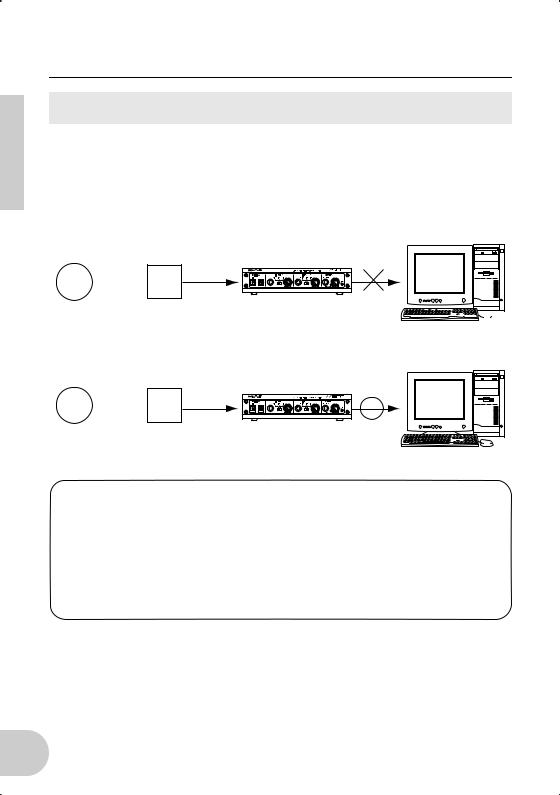
UW500 Features
Notes on musical copyrights
The UW500 supports SCMS (Serial Copy Management System) to protect the copyrights of music software. When you digitally copy data from CDs, or other music software purchased from stores, to your own media (such as MDs), information regarding digital recording generation is also recorded. If you route the recorded data to the DIGITAL IN jack, the data cannot be recorded on the computer. Use analog inputs (INPUT 1-3 jacks) to record data on the computer.
digital |
digital |
CD  MD
MD
computer
UW500
You cannot 









 record.
record. 









computer
UW500
digital |
analog |
CD  MD
MD
You can record.
It is prohibited to use copyrighted songs and sound data (that can be recorded via the UW500) for commercial purposes. It is also prohibited to reproduce, transfer, or distribute the data, or play the data for a commercial audience without permission from the owners of the copyright, except for personal use or application that does not infringe the copyright. If you wish to use such data for occasions other than personal use, consult a copyright expert. Yamaha is not responsible for any data created, reproduced, or edited using the UW500, nor for any reproduction or use of such data.
8

Package Contents
The UW500 package contains the following items. Check the contents for missing items.
•UW500 main unit
•Power adaptor (PA-3B)
(The power adaptor may not be included in the package in some areas.)
•CD-ROM
•USB cable (approx. 2m)
•Owner’s manual (this book)
About the included software
The included CD-ROM contains the following software.
•USB-MIDI driver (YAMAHA USB-MIDI Driver)
This driver enables the UW500’s MIDI functions. See page 22 for information on installing the driver.
•XGworks lite V3.0A
This sequence software supports Windows 98 and offers you an opportunity for high-quality music production. It lets you to create MIDI performance data and process audio data for advanced music post production.
To start the installer, double-click “Setup.exe” in the “XGworks_” folder. Install the software following the instructions on the display.
For more information on using the software, refer to the “XGworks Manual” PDF file after you finish the installation. This file is located at [Start|Programs|YAMAHA XGworks lite Ver.3.0]. Please note that the included Help and PDF files are for XGworks V3.0. The following functions are not available in XGworks lite V3.0A.
• |
Staff Window and Printing the Staves |
• |
Auto Play |
• |
Drum Window |
• |
Importer |
• |
Control Section |
• |
SW1000XG Mixer |
• |
Voice To Score R |
• |
Voice To Score |
• |
Auto Arranger |
• |
XF Information Editor |
• |
Guitar Arranger |
|
|
9
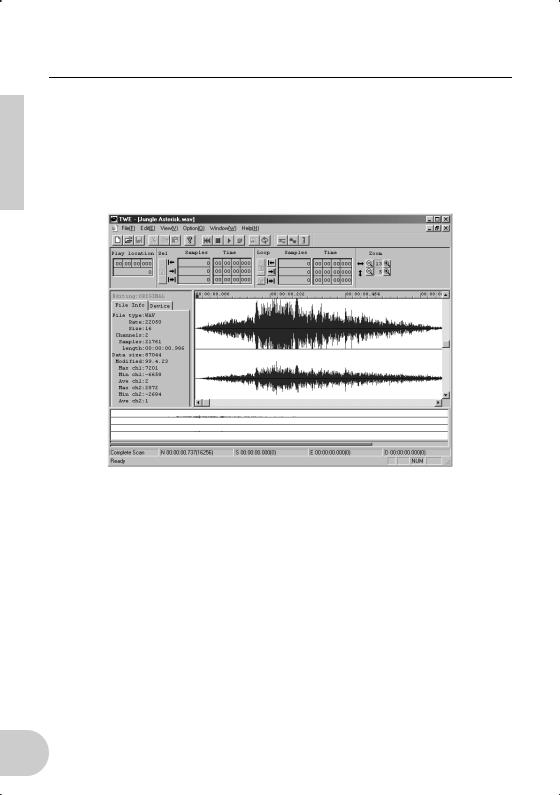
Package Contents
•Wave Editor TWE
Wave Editor TWE is used to record and edit Wave files. It is suitable for loading and editing the Wave files recorded using XGworks.
This software is installed along with XGworks. To start the application, select [Wave Editor TWE] from the [Job] menu in XGworks. For more information on using the software, refer to the “Wave Editor TWE Manual” PDF file after you finish the installation. This file is located at [Start|Programs|YAMAHA XGworks lite Ver.3.0].
•SoftSynthesizer (S-YXG50)
The S-YXG50 is XG tone generator software that produces voices using the computer’s CPU power. By installing SoftSynthesizer, you can enjoy high quality tones from MIDI data performance without connecting an external XG tone generator.
To start the installer, double-click “Setup.exe” in the “Syxg50_” folder. Install SoftSynthesizer according to the instructions on the display.
For more information on using the software, refer to the “S-YXG50 Help” file after you finish the installation. This file is located at [Start|Programs|YAMAHA SoftSynthesizer S-YXG50].
•Acrobat Reader
The Acrobat Reader allows you to view the electronic Owner’s Manual saved in PDF format.
To start the installer, open the “English” folder in the “Acroread” folder, then dou- ble-click the “Ar40eng.exe.” Install the software according to the instructions on the display.
10

System Requirements
OS: |
Windows 98 or Windows 98 Second Edition |
|
Computer: |
USB-supported IBM-PC or compatible computer |
|
CPU: |
Pentium 166MHz or higher (MMX Pentium 233 MHz or higher is recom- |
|
|
mended.) |
|
Memory: |
32MB or higher (64 MB or higher is recommended.) |
|
Hard Disk: |
2MB or more of free space |
|
|
NOTE To use XGworks lite V3.0, 30MB or more of hard disk space is |
|
|
|
|
|
required. To use Wave files, much more space is required. |
|
11
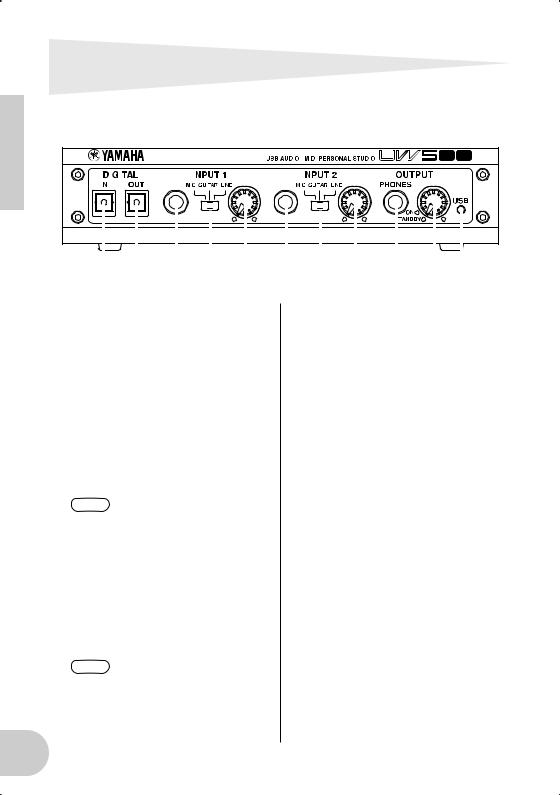
Parts and Functions
■ Front Panel
|
|
|
|
|
|
|
|
|
|
|
|
|
|
|
|
|
|
|
|
|
|
|
|
|
|
|
|
|
|
|
|
|
|
|
|
|
|
|
|
|
|
|
|
|
|
|
|
|
|
|
|
|
|
|
|
|
|
|
|
|
|
|
|
|
|
|
|
|
|
|
|
|
|
|
|
|
|
|
|
|
|
|
|
|
|
|
|
|
|
|
|
|
|
|
|
|
|
|
|
|
|
|
|
|
|
|
|
|
|
|
|
|
|
|
|
|
|
|
|
|
|
|
|
|
|
|
|
|
|
|
|
|
|
|
|
|
|
|
|
|
|
|
|
|
|
|
|
|
|
|
|
|
|
|
|
|
|
|
|
|
|
|
|
|
|
|
|
|
|
|
|
|
|
|
|
|
|
|
|
|
|
|
|
|
|
|
|
|
|
|
|
|
|
|
|
|
|
|
|
|
|
|
|
|
|
|
|
|
|
|
|
|
|
|
|
|
|
|
|
|
|
|
|
|
|
|
|
|
|
|
|
|
|
|
|
|
|
|
|
|
|
|
|
|
|
|
|
|
|
|
|
|
|
|
|
|
|
|
|
|
|
|
|
|
|
|
|
|
|
|
|
|
|
|
|
|
|
|
|
|
|
|
|
|
|
|
|
|
|
|
|
|
|
|
|
|
|
|
|
|
|
|
|
|
|
|
|
|
|
|
|
|
|
|
|
|
|
|
|
|
|
|
|
|
|
|
|
|
|
|
|
|
|
|
|
|
|
|
|
|
|
|
|
|
|
|
|
|
|
|
|
|
|
|
|
|
|
|
|
|
|
|
|
|
|
|
|
|
|
|
|
|
|
|
|
|
|
|
|
|
|
|
|
|
|
|
|
|
|
|
|
|
|
|
|
1 |
2 |
3 |
4 |
|
5 |
6 |
7 |
8 |
||||||||||||||||||||||||
ADIGITAL IN jack
Digital signal is input here from an MD or CD player using an optical digital cable (with a square plug). Set the INPUT SELECT switch on the rear panel to “DIGITAL.”
BDIGITAL OUT jack
This jack is used to record a digital signal from the computer to a digital recorder, such as an MD recorder. Use an optical digital cable (with a square plug) for connection.
NOTE Signals input at INPUT 1-3, AUX IN and DIGITAL IN cannot be route directly to the DIGITAL OUT jack.
CINPUT 1/2 jacks
Audio signal is input here from a microphone, electric guitar, electric bass, electronic musical instrument, or CD player. Use a standard monaural plug cable for connection.
NOTE To use INPUT 1-3 jacks, set the INPUT SELECT switch on the rear panel to “STEREO” or “MONO.”
DINPUT 1/2 gain switches
These switches enable you to select a type of signal input at INPUT 1 and 2 jacks.
For stereo line input, set the gain switch to “LINE” and input the left signal to the INPUT 1 jack and the right signal to the INPUT 2 jack. Set the INPUT SELECT switch on the rear panel to “STEREO.”
EINPUT 1/2 volume knobs
These volume knobs enable you to adjust the volume level of the audio signal input at INPUT 1 and 2 jacks.
FPHONES jack
Connect headphones with a standard jack here. Use the OUTPUT knob to adjust the headphone volume.
12

Parts and Functions
GOUTPUT knob
This knob has two functions. It switches the power on and off (stand-by) each time a click sound is heard when you turn the knob When the power is on, the knob enables you to adjust the UW500’s overall volume. Note that the OUTPUT knob setting does not affect the output at the DIGITAL OUT jack and the input at the AUX IN jacks on the rear panel.
Even when the power is off (standby), a small current flows through the unit. If you plan not to use the UW500 for a long period of time, be sure to remove the power adaptor from the AC outlet.
HUSB LED
The LED lights up in red when the power is turned on to the UW500. It lights up in green when the computer is connected to the UW500 correctly. It flashes in green when the UW500 transmits or receives MIDI signal.
The LED lights up in orange if the INPUT SELECT switch is set to “TRACK DOWN” (page 15).
The LED flashes in orange if the sampling frequency of the signal input at the DIGITAL IN jack is not appropriate. In this case, select the correct frequency option in the application on the computer according to the sampling frequency of the input signal.
The LED flashes in red and green alternately when the copyrighted signal is input at the DIGITAL IN jack. The signal cannot be recorded on the computer (page 8).
13

Parts and Functions
■ Rear Panel
9 0 A B C |
D |
E F G |
L
R
IOUTPUT jacks
These jacks are used to connect a playback device, such as powered speakers, or a recording device, such as a tape recorder. Use RCA pin-plug cables for L and R connection.
JAUX IN jacks
These jacks are used to connect an audio device, such as a CD player. The input signal is routed to the OUTPUT jacks and PHONES jack, bypassing the computer. (The signal is not routed to the DIGITAL OUT jack.) Use RCA pin-plug cables for L and R connection.
NOTE You cannot record an audio signal input from these jacks to the computer. To record audio to the computer, use the INPUT 3 jacks.
KINPUT 3 jacks
These jacks are used to connect an audio device, such as a CD player. You can record audio signals input here to the computer. Use RCA pinplug cables for L and R connection.
|
NOTE Even if the INPUT SELECT |
|
switch is set to “MONO,” |
|
these jacks receive stereo |
14 |
signals. |
|
LDC IN jack
Connect the PA-3B power adaptor here.
Before connecting the power adaptor, make sure that the OUTPUT knob on the unit is set to standby (off). Connect the power adaptor to the DC IN jack, then plug the adaptor into the AC outlet.
MINPUT SELECT switch
This switch enables you to select the input jacks (INPUT 1-3 or DIGITAL IN) and select the type of input signal.
To input stereo signals from an electronic musical instrument or audio device to INPUT 1-2 jacks (left signal to INPUT 1 and right signal to INPUT 2), set this switch to “STEREO.” To input monaural signals from a microphone or electric guitar to INPUT 1 and 2 jacks, set the switch to “MONO.” To input digital signals to the DIGITAL IN jack, set the switch to “DIGITAL.”
NOTE You cannot use DIGITAL IN and INPUT 1-3 at the same time.
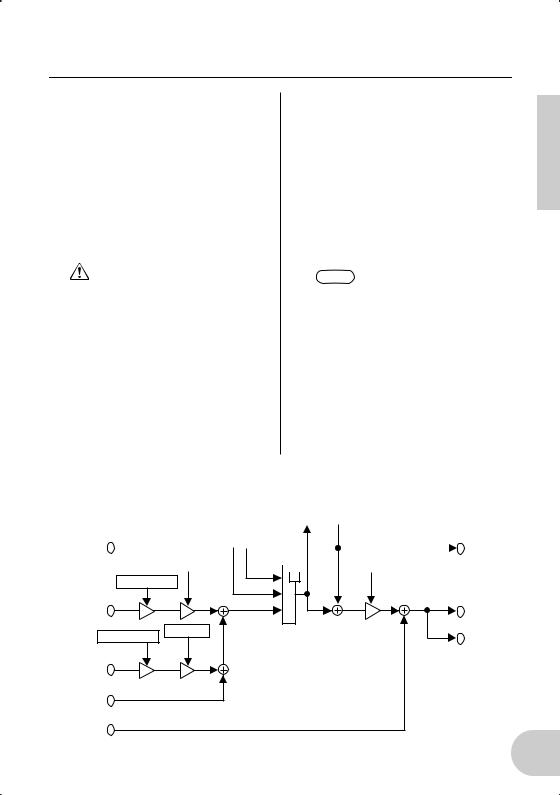
Parts and Functions
If you set this switch to “TRACK DOWN,” audio signals output from the USB terminal are sent back to the USB terminal unmodified. This setting is useful for tracking down multiple Wave files or audio signals from SoftSynthesizer into a single Wave file (page 39). In this case, the USB LED lights up in orange and the INPUT 1-3 jacks and DIGITAL IN jack are disabled.
With some application programs, input audio signals may be output unmodified. In this case, do not set the INPUT SELECT switch to “TRACK DOWN.” Otherwise, audio signals may oscillate, causing hearing loss or damage to the playback device.
NMIDI IN terminal
This jack receives MIDI signals from a connected MIDI device. Use a MIDI cable to connect the MIDI OUT terminal of the MIDI device to this jack.
OMIDI OUT terminal
This jack transmits MIDI signals to a connected MIDI device. Use a MIDI cable to connect the MIDI IN terminal of the MIDI device to this jack.
PTO TG terminal
Connect this terminal to the TO HOST terminal on the MIDI devices. Use an optional 8-pin system peripheral cable for Apple Macintosh for connection.
NOTE Set the HOST SELECT switch of the connected MIDI device to “PC-1” or “Mac”, regardless of the computer you are using.
QUSB terminal
Connect this terminal to a computer’s USB terminal or a USB hub using a USB cable.
■ Audio Signal Flow
|
|
|
|
|
|
|
|
|
USB |
|
|||
DIGITAL IN |
|
|
|
|
|
|
|
|
|
|
|
|
DIGITAL |
|
|
|
|
TRACK |
|
|
|
|
OUT |
||||
|
|
|
|
|
|
|
|
|
|||||
|
|
Volume |
|
|
DOWN |
|
|
|
|
|
OUTPUT |
|
|
Gain switch |
|
DIGITAL |
|
|
|
INPUT1 |
|
ANALOG |
(mono) |
|
PHONES |
|
|
|
Gain switch |
Volume |
INPUT SELECT |
|
OUTPUT |
|
INPUT2 |
|
|
(mono) |
|
|
INPUT3 |
|
|
AUX IN |
|
|
15

Connection
This section explains how to connect audio devices (such as a speaker or microphone) or MIDI devices (such as a tone generator or MIDI keyboard) to the UW500.
MIDI keyboard
power adaptor
computer
CD, MD player
MIDI terminal |
tone generator |
|
|
|
|
|
audio |
|
TO HOST terminal |
device |
|
|
|
||
9 |
8 |
7 |
speaker |
1 |
|
||
|
|
|
|
USB terminal |
6 |
2 |
|
5 headphones
3 4
OPTICAL jack
digital |
microphone |
recorder
guitar
16
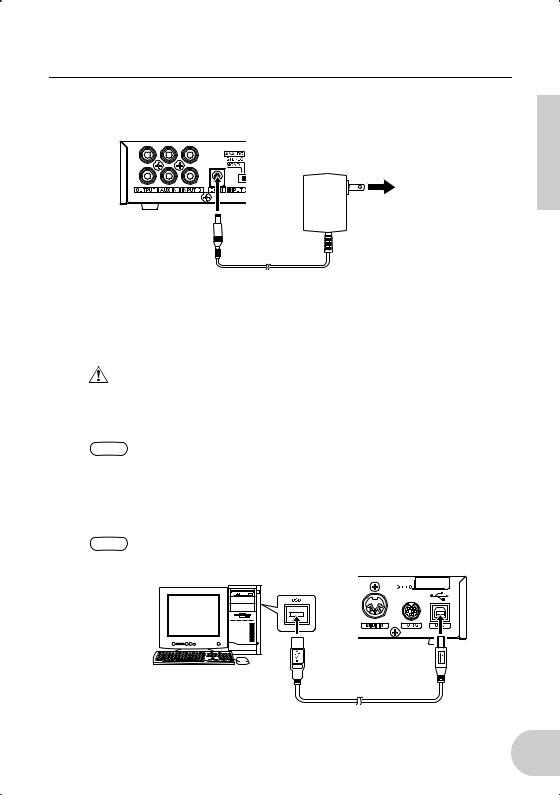
Connection
(1) Connecting the power adaptor
UW500
L
power adapter (PA-3B)
R
AC Outlet
1.Set the OUTPUT knob on the UW500 to standby (off).
2.Connect the plug of the power adaptor (PA-3B) to the DC IN jack on the rear panel of the UW500.
3.Connect the power adaptor to the appropriate AC outlet.
Be sure to use the PA-3B power adaptor or equivalent recommended by YAMAHA. Using a power adaptor with different current, voltage, or polarity specifications may cause a malfunction. If you plan not to use the UW500 for a long period of time, be sure to remove the power adaptor from the AC outlet.
NOTE Before you turn on the power to the UW500, make sure that the computer and the UW500 are connected correctly.
(2) Connecting a computer
Connect the USB terminal of a computer to the USB terminal of the UW500 using a USB cable. Be sure to turn off the power to the UW500 before making the connection.
NOTE For this connection, you do not have to turn off the power to the computer.
UW500
computer
USB cable
17
